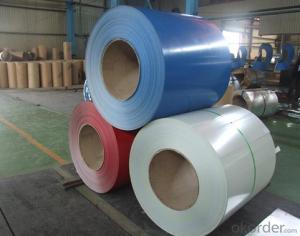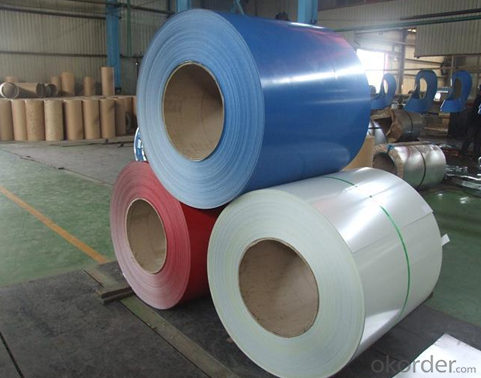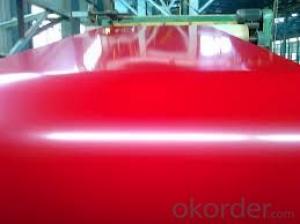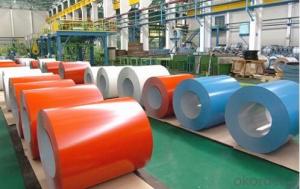Color Coated Galvanized Steel Coil/0.4mm-0.5mm Pre-Painted Galvanized Steel Roofing Sheet PPGI
- Loading Port:
- China main port
- Payment Terms:
- TT OR LC
- Min Order Qty:
- 25 m.t.
- Supply Capability:
- 10000 m.t./month
OKorder Service Pledge
OKorder Financial Service
You Might Also Like
Product Description
Color Coated Galvanized Steel Coil
ISO System
SGS and BV Audited company
Industry experience over 10 years
Management Systems-Internal Software
Finished Product Inventory-More Than 500 Tons
Raw Material inventory -Over 800 Mertic Tons
Shipment of goods -More than 30 countries worldwide
We have the most convenient transport and prompt delivery
We offer competitive price with best service
We have high technical production line with top quality products
We have win high reputation based on best quality products
Product Description
PPGI:
1, Introduction: Color coated steel coils(sheets), i. e. PPGI, also called prepainted steel coils(sheets), are made of galvanized steel coils(sheets) with polymer coatings as surface. It's a new enclosure material and building board with characteristics of light-weighted, heat preserved&insulated, easily installed with bright colors.
2, Production Process: Pretreatment(Degreasing)_Drying_Chromating_Paint Basic Oil_Cooling_Drying_Color Coating_Cooling_Film-covering_Rolling Up
3, Characteristics:
Good at corrosion resistence. Besides zinc coating of the basic plate of galvanized steel sheet, the color coating as the surface has double lifetime to ensure better anticorrosion effect.
with excellent cold bending molded manufacturablity, PPGI products can be processed or directly used as final product. As being light-weighted and conveniently transported, they're widly used to replace wood to save energy.
There're thousands of colors can be chosen as per different application. Any color plays well in decoration.
No pollution with high recycling rate, PPGI coils and sheets are strongly recommended as enviroment-friendly products by the government.
4, Appliance: Thanks to the above characteristics, color coated steel coils and sheets are widly used in construction, furniture industry, transportation industry, ect.
5, eye bands and 4 circumferential bands in steel, galvanized metal fluted rings on inner and outer edges, galvanized.
Type of substrate | Grade of color plate | Standard | Application& feature |
Hot dip galvanized | TDC51D+Z | DC51D+Z | ordinary use |
TDC52D+Z | DC52D+Z | SPCD | |
TDC53D+Z | DC53D+Z | SPCE | |
TS280GD+Z | TS280GD+Z | Structure use | |
TS350GD+Z | TS350GD+Z | Structure use | |
TS550GD+Z | TS550GD+Z | High strength structure use | |
Hot dip galvalume | TDC51D+AZ | DC51D+AZ | ordinary use |
TDC52D+AZ | DC52D+AZ | SPCD | |
TS250GD+AZ | S250GD+AZ | Structure use | |
TS300GD+AZ | 300GD+AZ | Structure use | |
TS350GD+AZ | 350GD+AZ | Structure use | |
TS550GD+AZ | 550GD+AZ | High strength structure use |
Type of coating process | Front:double coated&double drying |
Type of substrate | Hot dip galvanized,galvalume,zinc alloy,cold rolled steel,aluminium |
Coating | Top paint:10-25 micron(Normal 10-12 micron) |
Back paint:5-12 micron(Normal 5-7 micron) | |
ID(mm) | 508/610mm |
Coil weight(ton) | 3-9 ton |
Coating types | Top paint:PVDF,HDP,SMP,PE,PU |
Functions: | Decorative,Machinability,Weather resistance,Scrath resistance,Stain |
Primer paint: | polyurethane,Epoxy,PE |
Back paint: | Epoxy,modified polyester |
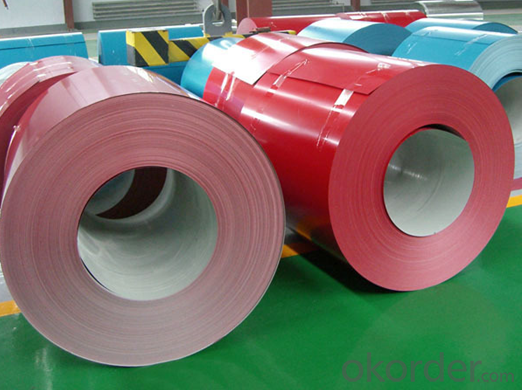
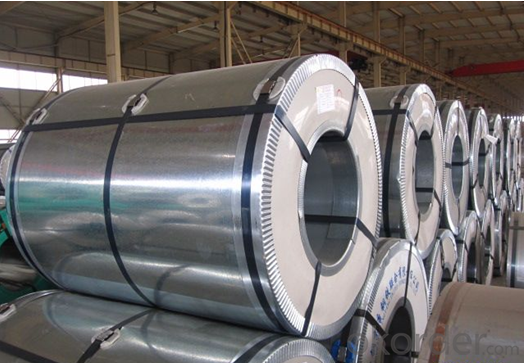
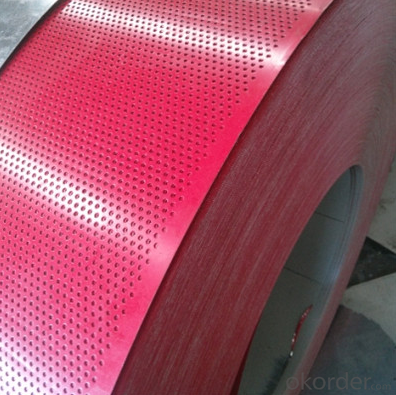
FAQ
1.What's your MOQ?
25MT, it is for one container.
2.Do you have QC teams?
Yeah, sure, our QC team is very important, they will keep the quality control for our products.
3.Are the products tested before shipping?
Yes, all of our PPGI and GI was qualified before shipping. We test every batch every day.
4. Is the sample available?
Yes, samples can be sent for test if you need.
- Q: A friends of mine says he has balls of steel and i told him i would melt em off with lava. He said it wouldnt work. i disagree
- Standard steel melts around 1400-1500 C. Erupting lava can be as hot as 1600 C. There are various types of steel with different melting points though, and the temperature of lava varies widely, so your question can't really be answered definitively. Some lava is definitely hot enough to melt steel though, so you are right and your friend is wrong. :)
- Q: How are steel coils used in the production of aerospace components?
- Steel coils find multiple applications in the production of aerospace components. One primary use involves their use in the manufacturing of structural parts like frames, beams, and brackets. To achieve this, steel coils are often transformed into flat sheets or strips, which are subsequently cut and shaped into the desired form for these components. Given the strong and durable nature of steel, it is an ideal material for these critical parts that must withstand extreme forces and conditions. Moreover, steel coils are also indispensable in the production of engine components, including turbine blades and combustion chambers. These components demand materials with exceptional mechanical properties and high resistance to elevated temperatures. Consequently, steel coils undergo processing and shaping to create intricate forms, ensuring the efficient and reliable functioning of these vital engine parts. Furthermore, steel coils play a crucial role in the production of fasteners, such as bolts, nuts, and screws, which are essential for assembling various aerospace components. The exceptional strength and corrosion resistance of steel make it the preferred choice for these fasteners, as they must endure the intense forces and harsh environments encountered during flight. In summary, the utilization of steel coils is of utmost importance in the production of aerospace components, as they provide the necessary strength, durability, and reliability required for safe and efficient operation in the demanding aerospace industry.
- Q: explain what happen if carbon steel is exposed to an oxygen rich atmosphere at elevated temperature inside a furnace.
- Assuming the steel isn't actually melted, two things will happen. First, a layer of iron(ii) oxide, FeO will slowly develop on the surface, getting thicker over time. This layer is usually poorly bonded to the metal surface, it tends to flake off, exposing fresh metal. This is known as mill scale, it's also known as wustite which is the mineral term. Second, the surface of the steel will become decarburized, essentially becoming pure iron, not steel. The depth of the decarburized layer depends on the temperature, time, and the diffusivity of carbon in the steel at the given temp. This has some implications to engineering, in hot-rolling or forging of steel shapes for example. It's often the case that the stress and strain in a material is greatest at or near the surface. Therefore the weakened, decarburized layer at the surface may have a much greater detrimental effect on the steel's performance than might be expected. In a more specific example, die and tool steels depend on their carbon content for their strength and wear resistance, Therefore if such steels are heated in an oxidzing atmosphere, wear resistance is totally destroyed: The thin decarburized iron layer will be extremely soft and malleable.
- Q: I know of the cheaper steel shot for waterfoul hunting, but there is more expensive shot available. Is it worth the money, how much more distance are we talking, and what do you like the best?(brand name)
- All buckshot I can think of at the moment is lead. Steel shot is used for waterfowl hunting because lead is illegal for that use. They don't want all that lead shot falling back in the water and causing lead contamination. There would be no reason to make steel buckshot, and it would be pretty ineffective. Steel is much less dense than lead. So a steel 00 pellet would weigh much less than a lead 00 pellet. So it would carry a lot less energy to a target. Buckshot is used for just that, Bucks. Well large game like deer, bear, and for self defense. In uses like that you need that extra energy. Lead shot is used for everything, except where lead shot is illegal, which is waterfowl hunting. Steel shot really isn't very popular anymore. Waterfowl shot just can't be lead. It doesn't have to be steel. They've come out with other stuff, like bismuth, that is a lot more dense than steel, but still not as dense as lead.
- Q: What are the common surface treatments for steel coils?
- The common surface treatments for steel coils include galvanizing, painting, and coating with protective films.
- Q: What are the dimensions of steel coils used in automotive component manufacturing?
- The dimensions of steel coils utilized in the manufacturing of automotive components can differ based on the distinct specifications of each component. Nevertheless, the industry typically adheres to standard dimensions, which usually span from 0.5 to 3 millimeters in thickness and 600 to 2,000 millimeters in width. The weight of these coils may vary, but typically falls within the range of 2 to 25 metric tons. These dimensions are carefully selected to ensure hassle-free processing and conversion of the coils into the essential automotive components, while simultaneously meeting the necessary standards for strength and durability, which are essential for their use in vehicles.
- Q: How are steel coils processed before they are used in manufacturing?
- Before being used in manufacturing, steel coils undergo several processing steps. The initial step, known as pickling, entails immersing the coils in an acid bath to eliminate any surface impurities such as rust or scale. This step serves to enhance the surface quality of the steel. After pickling, the coils are subjected to a process called cold rolling. This involves passing the coils through a set of rollers to decrease their thickness and enhance their dimensional accuracy. Additionally, cold rolling enhances the mechanical properties of the steel, rendering it stronger and more durable. Following cold rolling, the coils are annealed. This process involves heating the coils to a specific temperature and gradually cooling them. Annealing helps to alleviate internal stresses within the steel and improve its formability and ductility. Subsequently, the coils may undergo further surface treatments, such as galvanizing or coating. Galvanizing involves applying a layer of zinc to protect the steel from corrosion, while coating may involve applying various types of paint or polymer to enhance the steel's appearance or provide specific functionalities. Once the coils have undergone the necessary processing and treatments, they are typically cut into smaller sheets or strips according to the manufacturing requirements. These sheets or strips can then be utilized in various manufacturing processes, including stamping, forming, welding, or fabrication, to create a diverse array of products, ranging from automotive components to appliances, construction materials, and more. In summary, steel coils go through a series of processing steps, including pickling, cold rolling, annealing, and surface treatments, before they are prepared for use in manufacturing. These processes result in improved quality, strength, and formability of the steel, enabling it to be transformed into a wide range of products.
- Q: What are the different types of steel coil packaging materials?
- There are several different types of steel coil packaging materials, including steel strapping, stretch film, plastic wrap, metal bands, and wooden crates. These materials help protect and secure steel coils during transportation and storage.
- Q: i would like to make a dmascus steel knife, i have the cable but im not sure if its damascus steel or not, how do i tell? and if it isnt damascus steel how do i make a bar of it?
- Here's what you need, the cable should be a minimum of 9/16 with large wires. You need some borax (20 mule team from the store). A good hot coal, coke, or gas forge. If the cable has fiber rope in the center it will need to be removed. Fuse the ends of the cable to keep them from coming apart. I use my welder and while I'm at it I weld a handle to make it easier. Heat it in the forge when the forge is properly heated, rotate it. Some people will burn the oil out, but I've found that the forge does that just fine. Rotate the cable while it's heating. When it begins the turn red pull it out and sprinkle the borax over it, don't hold back use a lot. It will begin to melt and bubble into the steel. Put the cable back in the forge, rotate and watch. This is the critical part. When the steel starts to turn from orange/yellow to almost yellow/white take it out and lightly (I use a 2lb hammer) begin hammering the cable into a square or rectangle. If you do it right you'll notice that it will begin to fight the hammer, that's when you know the weld it taking place. You'll have to repeat the process down the length of the cable. Once you have the billet made you can begin the process of shaping the edge and tang. Once you have it shaped, follow proper forge procedure then grind all the yuck off and finish shaping. Then harden and temper and finish it out. Good luck. I almost forgot a very important part. Befor you start hammering put the cable in a vice while at welding temp (if you are strong you can use a couple of plyers) and twist it tight. On the next heat hold the cable in your left and and lay it on the anvil. Concentrate on your light hammer blows being on your side of the cable. This forces the cable strands together. If you are using smaller cable like 9/16 you can double the cable up and weld two peices together, it is easier and makes for a prettier blade. Doing this you don't have to worry about twisting the cable and you can hit it much harder to start with.
- Q: How are steel coils inspected for weldability?
- Steel coils are inspected for weldability through a series of comprehensive tests and examinations. The main objective of this inspection is to assess the quality and suitability of the steel coils for welding processes. Firstly, visual inspection is conducted to identify any visual defects or irregularities on the surface of the coils. This includes checking for surface roughness, cracks, scratches, or any other imperfections that may affect the weldability. Next, destructive testing methods such as tensile testing and impact testing are performed. Tensile testing measures the strength and ductility of the steel, ensuring it meets the required mechanical properties for welding. Impact testing evaluates the steel's resistance to brittle fracture, which is crucial in determining its weldability. Furthermore, non-destructive testing techniques such as ultrasonic testing (UT) and magnetic particle inspection (MPI) are employed to detect internal defects and discontinuities. UT uses high-frequency sound waves to identify any hidden flaws within the steel, while MPI utilizes magnetic particles to identify surface and near-surface defects. Additionally, chemical analysis is carried out to determine the steel's composition and ensure it meets the required specifications for welding. This analysis involves checking the levels of carbon, manganese, sulfur, and other elements that may affect the weldability and overall performance of the steel. Moreover, weldability testing is performed to evaluate the steel's response to welding processes. This involves conducting various welding trials using different techniques and parameters to determine the steel's behavior during welding, such as its susceptibility to cracking, distortion, or other welding-related issues. Overall, the inspection of steel coils for weldability is a multi-faceted process that combines visual, destructive, non-destructive, chemical, and weldability testing methods. By conducting these thorough inspections, manufacturers can ensure that the steel coils meet the required standards and are suitable for welding applications.
Send your message to us
Color Coated Galvanized Steel Coil/0.4mm-0.5mm Pre-Painted Galvanized Steel Roofing Sheet PPGI
- Loading Port:
- China main port
- Payment Terms:
- TT OR LC
- Min Order Qty:
- 25 m.t.
- Supply Capability:
- 10000 m.t./month
OKorder Service Pledge
OKorder Financial Service
Similar products
Hot products
Hot Searches
Related keywords
